Blog
Health & Safety
Vibrio vulnificus
PENSACOLA, Fla. -- An Alabama man is battling a case of Vibrio vulnificus Wednesday, often called the "flesh eating bacteria," after coming in contact with it in Little Sabine Bay on Pensacola Beach earlier this month.
The man's son says his dad was in contact with the bacteria on July 9 while watching the Blue Angels in Little Sabine Bay at Pensacola Beach.
The man's family believes 75-year-old William Pledger contracted the flesh eating bacteria in the bay, which caused him to have his lower left leg was amputated several days later.
Pledger's son, John Patrick Pledger, said they travel to Pensacola every year to see the Blues.
"Got in the water," John said. "At some point the whole family was in the water."
Five days later, Pledger's leg began to get sore. By Friday morning, things took a turn for the worse.
"In severe pain, could not sit still, his leg had started swelling up," John said.
Pledger's wife took him to the Mobile Infirmary Hospital. He was diagnosed with the flesh eating bacteria Vibrio vulnificus.
Pledger's left leg was in bad shape.
"Everything from soft tissue from the knee down was destroyed," John said.
Pledger's leg was amputated from the knee down.
Earlier this month, the Department of Public Health in Escambia County issued a public health warning about Vibrio in area waters. They urged people who have cuts not to go in the water.
Pledger's family said he was nursing a cut on his left leg.
"He had a small cut on his left leg, it was scabbed over, didn't look too bad," John said. "It was very small."
Pledger's family say he wasn't in any other body of water besides the bay on Pensacola Beach.
"It was very emotional watching my dad go through all this," John said.
Vibrio symptoms include vomiting, abdominal pain and blistering.
This year, there's been one reported case of Vibrio in Escambia County. Last year, there were 11.
"Take care of yourself stay out of the water," John said. "It's just a bad deal."
Family says Pledger has a long road of recovery. He still has the bacteria in his system.
They suspect he will be hospitalized for months.
UPDATE:
A 75-year-old Mobile man has died after contracting the “flesh-eating bacteria” vibrio in the waters off Pensacola Beach, and his family hopes the incident will raise awareness of the life-threatening infection… His leg had to be amputated and he remained in critical condition until he died from the infection Friday, according to Pledger’s daughter-in-law Crystal McCreight-Pledger.
Vibrio vulnificus Fact Sheet (PDF)
This disease can be contracted either by ingesting the bacteria, such as eating raw shellfish, or by open wound contamination—such as in the case above. Once the symptoms appear, rapid and radical treatment is necessary to save the life of the victim.
Be alert, be careful.
/fl
Gun Control
Fifteen Seconds…
… and the scene is secure!
The media may keep referring to Eli as a “bystander”, but he is in reality the manifestation of an heretofore unrecognized concept; a 'citizen first-responder' demonstrating the only kind of 'gun control' that is truly effective.
Good work Eli!
UPDATE (For anyone who may be considering a role as a Citizen First Responder): Owing to the fact that deadly-force encounters in our society are heavily scrutinized, as well they should be, here is some pertinent commentary regarding crucial legal issues that come attached to incidents such as this:
Stay safe!
/fl
Marine Safety: Stability
Capsize
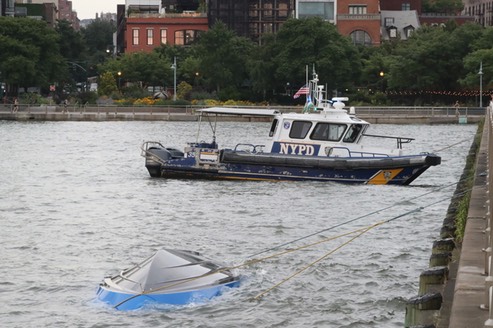
Just as water seeks its own level, a boat will seek its most stable position; even the “unsinkable" ones. Boats like this shallow V design offer good initial stability, but relatively poor ultimate stability. It doesn’t take much water ingress to upset them, especially if they are overloaded—as it appears that this one (pictured above) was.
There are eight million stories about times when it was better to enjoy the water from the shore, than to try to enjoy the shore from the water—this is one of them.
Sad.
/fl
Navigation
Be careful to not “run aground" on technology
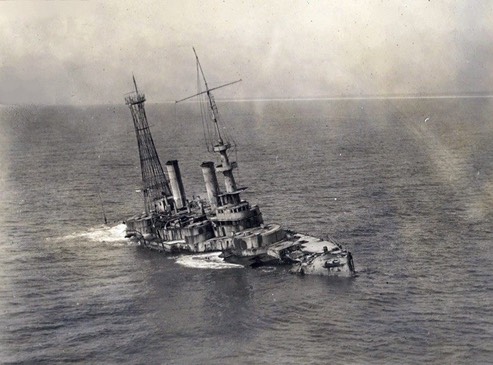
WW-1 Battleship USS Massachusetts
A recent case in point; The Coast Guard reports that "Watchstanders at Coast Guard Sector Mobile received a mayday call at 10:47 a.m. from the 50-foot Sport Fisher Slow Motion. The recreational vessel reportedly "ran aground", with all nine boaters aboard abandoning the vessel. Watchstanders diverted a 45-foot Response Boat-Medium boatcrew from Coast Guard Station Pensacola that was already patrolling the area."
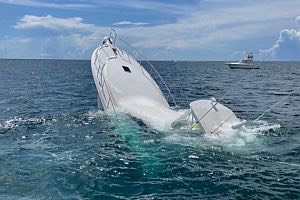
The Coast Guard rescued nine people after their vessel "ran aground" and started to take on water July 9, 2022 near Pensacola Pass, Florida. Watchstanders diverted a 45-foot Response Boat - Medium boatcrew from Coast Guard Station Pensacola to assist and all nine people were rescued with no injuries. (U.S. Coast Guard courtesy photo)
"The Pensacola boatcrew arrived on scene at 10:56 a.m., recovered all nine people out of the water and transported them back to Big Lagoon State Park in Pensacola.”
At and near the location where this boat sank, there is no water shallow enough for a sportfishing boat this size to run aground in the conventional sense, so I'm assuming that they hit the top of the sunken Battleship. Why? It was broad daylight in good weather!
I have not seen any official investigative reports concerning what the helm-watch on Slow Motion was doing, other than the boat was eastbound along the coast. They evidently didn’t know that they had hit a battleship. The wreck is not only charted, but it is a popular site for fishermen and sport divers. The wreck-site is marked with a lighted red buoy that is listed in both the Light List and on nautical charts.
The “old style” raster chart shows it thusly:
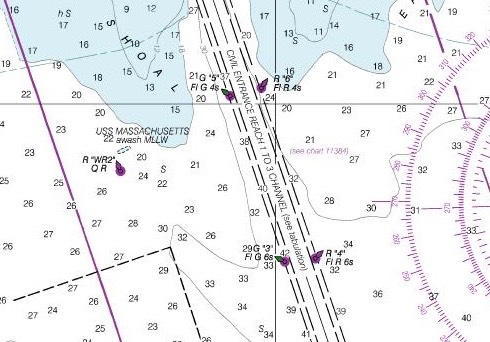
The newer ENC chart shows a little less detail concerning the relationship of the buoy to the wreck:
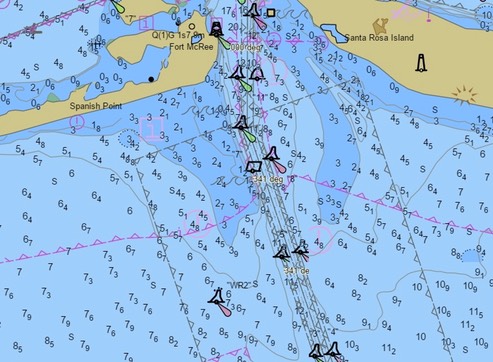
Either way, the rule is still the same; keep the coastal red buoys (and their red lights) between your boat and the shore when you are traveling offshore along the coast.
How do you discern whether a buoy is a coastal mark or a channel mark? The best answer to that question is, either with local knowledge, or by using a nautical chart. Our system of buoyage is designed to be used WITH a chart (and nowadays it doesn’t hurt to have a Light List handy)—especially when you are in unfamiliar waters.
An expensive “catch” for ’Slow Motion' that was!
Stay safe.
Click here for some history about the Battleship USS Massachusetts (BB-2).
/fl
